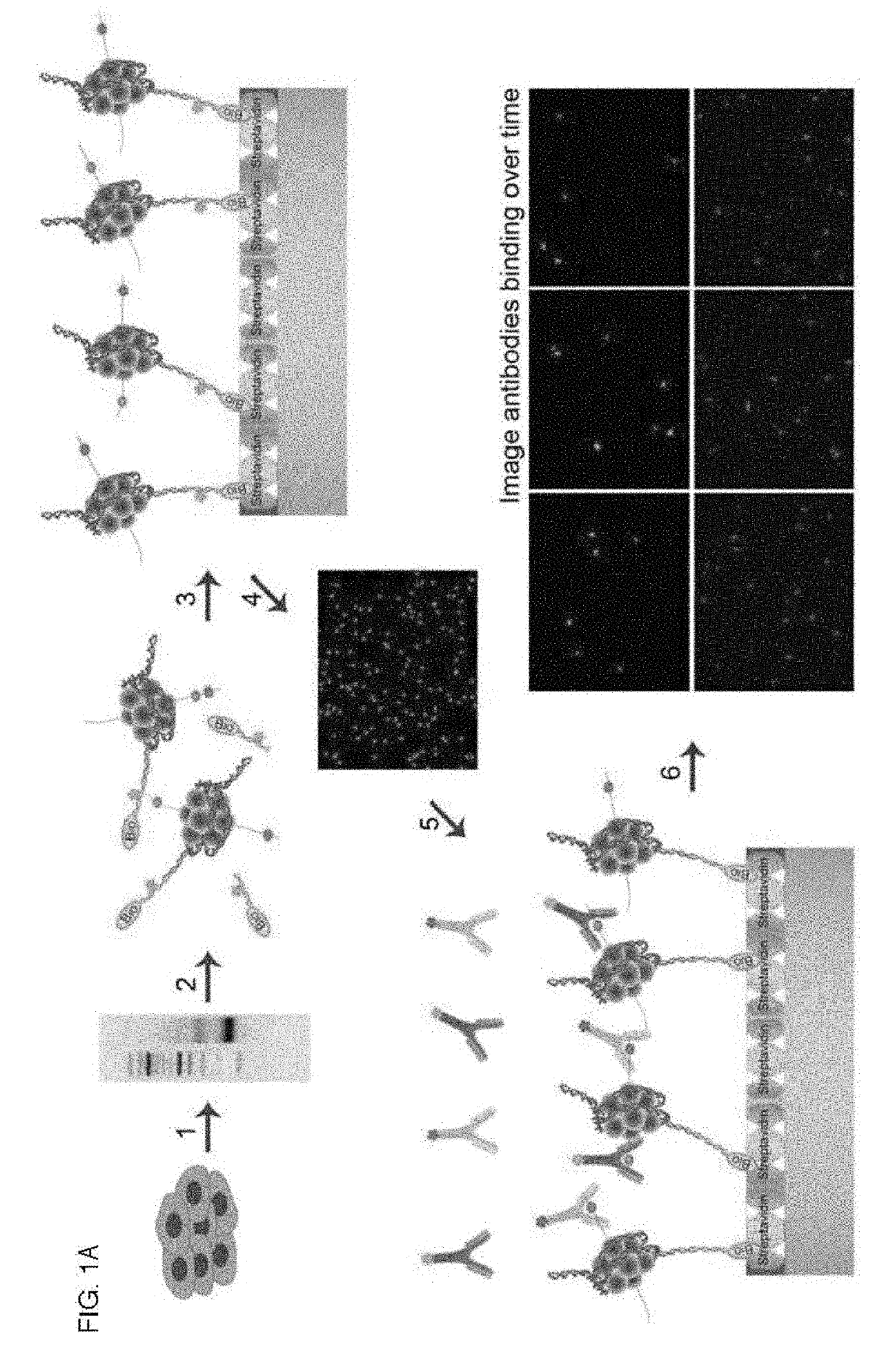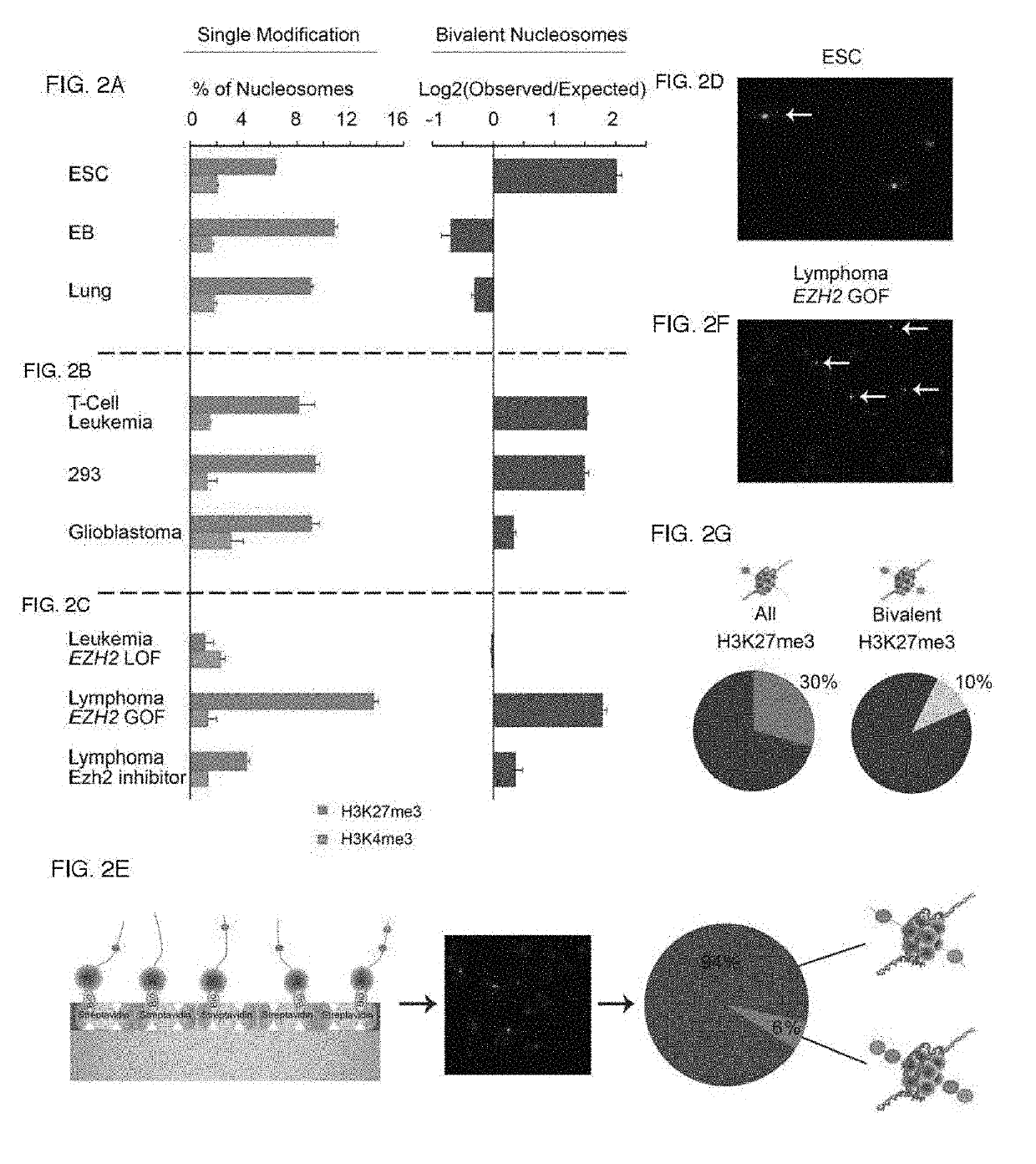Combinatorial single molecule analysis of chromatin
a single molecule and chromatin technology, applied in the field of combinatorial single molecule profiling of combinatorial protein modifications, can solve the problems of inability to effectively distinguish whether coincident marks co-exist on the same nucleosome, inability to detect, quantify and map combinatorially, and difficulty in testing hypotheses
- Summary
- Abstract
- Description
- Claims
- Application Information
AI Technical Summary
Benefits of technology
Problems solved by technology
Method used
Image
Examples
example 1
Characterization of the Combinatorial Pattern of Histone Modifications on a Single Nucleosome.
[0214]Applicants established a single-molecule-based assay for investigating the nature and functional significance of combinatorial histone modifications (FIG. 1A, 6, 7). Applicants begin by isolating mono-nucleosomes from cells. Applicants lysed cells and treated the chromatin with MNase, which cuts linker DNA between nucleosomes. Nucleosomes are isolated and ligated to fluorescent, biotinylated oligonucleotide adaptors at their free DNA ends. Samples are loaded on 10-30% glycerol gradients and ultra-centrifuged ˜18 hours. Fractions are collected and analyzed on gels to select purified adaptor-ligated mono-nucleosomes. Ligated nucleosomes are captured in a spatially distributed manner on PEG-streptavidin coated slides (11,12). The PEG-streptavidin coated slides are assembled in a flow cell. Applicants capture labeled nucleosomes on the surface via the biotin streptavidin interactions. Nuc...
example 2
[0216]Characterization of the Pattern of Histone H3 Lysine 27 and Lysine 4 Trimethylation (H3K27me3 and H3K4me3)
[0217]In embryonic stem cells (ESCs), developmental gene promoters appear to be concomitantly marked by repressive (H3K27me3) and activating (H3K4me3) histone modifications (13, 14). This ‘bivalent’ chromatin state is proposed to ‘poise’ these critical genes for rapid activation or repression upon differentiation. Yet the functional significance of bivalent chromatin remains controversial, in part because current methods do not adequately characterize their structure (15-17). Evidence for co-occurrence of the opposing marks on the same nucleosome comes from immunoprecipitation studies, including sequential ChIP and IP-mass spectrometry (IP-MS) (13, 18-22). Yet such enrichment-based assays yield relative measures and cannot definitely identify an individual bivalent nucleosome. More broadly, ChIP-based comparisons of modifications may be obscured by cellular heterogeneity, ...
example 3
[0223]Applicants next explored other nucleosomal states, including higher-order combinations of the histone modifications H3K4me3, H3K27me3, H3K27me2 and H3K27ac (FIG. 3A). Monitoring four or more histone modifications on single nucleosomes is carried out in successive steps of antibody incubation and imaging, which are separated by a wash step to remove antibodies (see Methods). H3K27me2 is a prevalent modification state associated with large intergenic genomic regions, which are largely exclusive with H3K27me3 regions (7). H3K27ac is an active mark associated with active enhancers and promoters (33-36). Single molecule counting reveals that the proportions of nucleosomes marked by each of the four modifications are similar in ESCs and lung fibroblasts, with exception that the H3K27 methylation levels increase modestly in the differentiated cells (FIG. 3A). However, when Applicants considered these modifications in combination, Applicants observed more striking differences between ...
PUM
| Property | Measurement | Unit |
|---|---|---|
| Tm | aaaaa | aaaaa |
| Tm | aaaaa | aaaaa |
| Tm | aaaaa | aaaaa |
Abstract
Description
Claims
Application Information
 Login to View More
Login to View More - R&D
- Intellectual Property
- Life Sciences
- Materials
- Tech Scout
- Unparalleled Data Quality
- Higher Quality Content
- 60% Fewer Hallucinations
Browse by: Latest US Patents, China's latest patents, Technical Efficacy Thesaurus, Application Domain, Technology Topic, Popular Technical Reports.
© 2025 PatSnap. All rights reserved.Legal|Privacy policy|Modern Slavery Act Transparency Statement|Sitemap|About US| Contact US: help@patsnap.com



